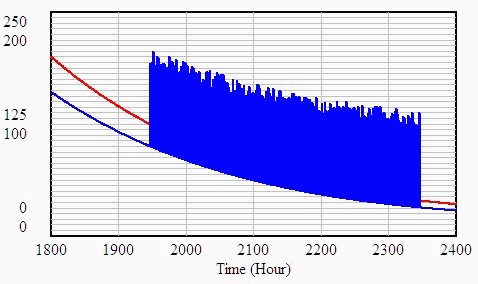4.25. FORRESTER DIAGRAM WITH VENSIM
A simulation model with Vensim
 With the aim of eradicating widespread ancestral superstitions, scientists study and attempt to explain strange phenomena.
This investigation studies an electrical phenomenon with no logical explanation: a street lamp that starts to behave oddly when night falls. The street lamp's bulb begins to turn itself on and off at two-second intervals and a few hours later, always before daybreak, the light bulb burns out. In this way, a succession of light bulbs are destroyed in what seems to be an assault of the street lamp on the light bulbs.
No anomalies are observed in the street lamp's electrical and mechanical components, and all the tests carried out by various technicians have demonstrated an absence of manufacturing faults.
Different brands of light bulbs have been tested and the wiring has been checked on numerous occasions. Furthermore, there are similar street lamps in the surrounding area that work perfectly well. So far, no plausible explanation for this strange phenomenon has been found.
RESEARCH TEAMS
FIRST RESEARCH TEAM
The first research team was made up of an electrical engineer specialising in underground conductivity, a mechanical engineer with widespread experience in industrial assembly and a well-known urban planner.
This first team drew up a detailed document describing the street lamp's location and its electrical and physical components. They were unable to find the cause of the strange behaviour within the specified time limit.
However, when a strange electrical problem affected the computer where it had been stored, this valuable document vanished.
SECOND RESEARCH TEAM
A second research team with a very different profile was set up: the collaborators included a clairvoyant specialising in paranormal phenomena, a retired gardener and his assistant, an estate agent and a municipal police officer acquainted with the area, as well as the tenants and former doormen of the block of flats in front of which the street lamp is situated, who offered their disinterested contributions.
The meetings held by this second group were fraught with difficulties from the start, due to the aggressive attitude of several of the tenants, and the police officer's insistence on directing the investigation.
In an attempt to reach some form of consensus, the team was supplemented with a group of psychologists specialising in behavioural disorders, a famous Argentinean psychiatrist, an American journalist, a biologist and a landscape technician.
This second team never managed to draw up a report due to the persistent differences of opinion between several of its members, which made it impossible to settle on a final document.
THIRD RESEARCH TEAM
Finally, a team of lecturers and students of System Dynamics were entrusted with the research, which they were to use as fieldwork in their study of counterintuitive phenomena.
Their results, shown below, allowed them to understand why the phenomenon had occurred, and in their conclusions they were able to propose ways in which the problem could easily be solved.
THE THIRD RESEARCH TEAM'S FINAL REPORT
LOCATION
The street lamp that was the object of study is located in front of a block of flats at number 18 of the Doctor Francesc Darder street in Barcelona (Spain). The street is named after an explorer and biologist who returned from Namibia with the desiccated body of an enigmatic black sorcerer. The body was exhibited to the public in the town of Banyoles for more than fifty years.
The building is surrounded by a leafy area and there are two identical street lamps in front of it. Photographs of the building can be viewed at http://www.qdq.com. The street lamp exhibiting the enigmatic behaviour is the one situated next to the steps leading to the main entrance.
It might be worth noting that there is a chapel directly in front of the street lamp studied, and that the USA consulate in Barcelona is less than a hundred metres away.
DESCRIPTION OF THE STREET LAMP
The street lamp is made of metal and the post is painted white. At the top end of the post, there is a metal cylinder of the same colour with vents on either side, inside of which is the light bulb.
It is a 250-watt light bulb, receiving 220 volts of electric current. High-quality, energy-efficient, long-life Philips light bulbs are used for the street lamps in the building's immediate surroundings. Light bulbs of various types, brands and models were used in the investigation.
When daylight fades, the street lamp turns itself on automatically by means of a device that is fixed to the wall.
The research team prepared the following diagram. The top part of the document shows the sequence in which the light bulb turns itself on and off, including the time when it first switches itself on (because the bulb is controlled by a light sensor, this time may vary) and the intervals between switching on and off. After a long wait, the hour at which the light bulb burns out was recorded.
HYPOTHESES
The third research team began by gathering all the hypotheses propounded.
The tenants attributed the behaviour to strong lateral winds that penetrate through the side vents, banging the light bulb against the lamp and causing it to burn out. This theory fails to explain why the light bulbs burn out when there is no wind or why only the light bulbs in one street lamp burn out.
Other hypotheses involved the prayers spoken in the nearby chapel at night, and the sorcerer brought by Mr. Darder, the biologist, who might be seeking revenge.
There was also speculation surrounding a magnetic field that might be caused by a secret device installed in the nearby USA consulate, but the fact that all the other electrical equipment in the building functioned correctly failed to endorse this hypothesis.
ANALYSIS OF THE PROBLEM WITH A DYNAMIC SIMULATION MODEL
The third research team chose to disregard these theories due to their lack of rigour and because they do not in any way explain the phenomenon; instead they decided to carry out a dynamic simulation model.
They structured the model according to a causal diagram and then drew up a Forrester Diagram, which they introduced in a computer. The following diagram shows the final model, which includes the basic elements of the system studied.
In short, the model demonstrates that the sensor switches the light bulb on when the natural light is less than the desired value and switches it off when it exceeds this value.
When the light bulb switches itself on because there is little natural light, it shines on the light sensor, which reacts as if there was plenty of light and consequently turns the light bulb off. The system's behaviour clearly demonstrates that the oscillations occur as soon as the natural light descends to a certain value.
OBTAINED BEHAVIOUR
The model reproduces the light bulb's switching-on, switching-off sequence and one can conclude that it is this that causes the light bulb to burn out after a few hours.
To determine the street lamp's sensitivity to light, simulations that caused variations when it turned itself on were carried out.
Because there may be more or less natural light on sunny or cloudy days, the sensitivity to variations of the initial value of the amount of natural light was analysed.
The sensitivity was simulated at the speed at which natural light diminishes. This speed depends on the time of year; for example, it is faster in summer than in winter, because the sun is higher above the horizon.
With the aim of eradicating widespread ancestral superstitions, scientists study and attempt to explain strange phenomena.
This investigation studies an electrical phenomenon with no logical explanation: a street lamp that starts to behave oddly when night falls. The street lamp's bulb begins to turn itself on and off at two-second intervals and a few hours later, always before daybreak, the light bulb burns out. In this way, a succession of light bulbs are destroyed in what seems to be an assault of the street lamp on the light bulbs.
No anomalies are observed in the street lamp's electrical and mechanical components, and all the tests carried out by various technicians have demonstrated an absence of manufacturing faults.
Different brands of light bulbs have been tested and the wiring has been checked on numerous occasions. Furthermore, there are similar street lamps in the surrounding area that work perfectly well. So far, no plausible explanation for this strange phenomenon has been found.
RESEARCH TEAMS
FIRST RESEARCH TEAM
The first research team was made up of an electrical engineer specialising in underground conductivity, a mechanical engineer with widespread experience in industrial assembly and a well-known urban planner.
This first team drew up a detailed document describing the street lamp's location and its electrical and physical components. They were unable to find the cause of the strange behaviour within the specified time limit.
However, when a strange electrical problem affected the computer where it had been stored, this valuable document vanished.
SECOND RESEARCH TEAM
A second research team with a very different profile was set up: the collaborators included a clairvoyant specialising in paranormal phenomena, a retired gardener and his assistant, an estate agent and a municipal police officer acquainted with the area, as well as the tenants and former doormen of the block of flats in front of which the street lamp is situated, who offered their disinterested contributions.
The meetings held by this second group were fraught with difficulties from the start, due to the aggressive attitude of several of the tenants, and the police officer's insistence on directing the investigation.
In an attempt to reach some form of consensus, the team was supplemented with a group of psychologists specialising in behavioural disorders, a famous Argentinean psychiatrist, an American journalist, a biologist and a landscape technician.
This second team never managed to draw up a report due to the persistent differences of opinion between several of its members, which made it impossible to settle on a final document.
THIRD RESEARCH TEAM
Finally, a team of lecturers and students of System Dynamics were entrusted with the research, which they were to use as fieldwork in their study of counterintuitive phenomena.
Their results, shown below, allowed them to understand why the phenomenon had occurred, and in their conclusions they were able to propose ways in which the problem could easily be solved.
THE THIRD RESEARCH TEAM'S FINAL REPORT
LOCATION
The street lamp that was the object of study is located in front of a block of flats at number 18 of the Doctor Francesc Darder street in Barcelona (Spain). The street is named after an explorer and biologist who returned from Namibia with the desiccated body of an enigmatic black sorcerer. The body was exhibited to the public in the town of Banyoles for more than fifty years.
The building is surrounded by a leafy area and there are two identical street lamps in front of it. Photographs of the building can be viewed at http://www.qdq.com. The street lamp exhibiting the enigmatic behaviour is the one situated next to the steps leading to the main entrance.
It might be worth noting that there is a chapel directly in front of the street lamp studied, and that the USA consulate in Barcelona is less than a hundred metres away.
DESCRIPTION OF THE STREET LAMP
The street lamp is made of metal and the post is painted white. At the top end of the post, there is a metal cylinder of the same colour with vents on either side, inside of which is the light bulb.
It is a 250-watt light bulb, receiving 220 volts of electric current. High-quality, energy-efficient, long-life Philips light bulbs are used for the street lamps in the building's immediate surroundings. Light bulbs of various types, brands and models were used in the investigation.
When daylight fades, the street lamp turns itself on automatically by means of a device that is fixed to the wall.
The research team prepared the following diagram. The top part of the document shows the sequence in which the light bulb turns itself on and off, including the time when it first switches itself on (because the bulb is controlled by a light sensor, this time may vary) and the intervals between switching on and off. After a long wait, the hour at which the light bulb burns out was recorded.
HYPOTHESES
The third research team began by gathering all the hypotheses propounded.
The tenants attributed the behaviour to strong lateral winds that penetrate through the side vents, banging the light bulb against the lamp and causing it to burn out. This theory fails to explain why the light bulbs burn out when there is no wind or why only the light bulbs in one street lamp burn out.
Other hypotheses involved the prayers spoken in the nearby chapel at night, and the sorcerer brought by Mr. Darder, the biologist, who might be seeking revenge.
There was also speculation surrounding a magnetic field that might be caused by a secret device installed in the nearby USA consulate, but the fact that all the other electrical equipment in the building functioned correctly failed to endorse this hypothesis.
ANALYSIS OF THE PROBLEM WITH A DYNAMIC SIMULATION MODEL
The third research team chose to disregard these theories due to their lack of rigour and because they do not in any way explain the phenomenon; instead they decided to carry out a dynamic simulation model.
They structured the model according to a causal diagram and then drew up a Forrester Diagram, which they introduced in a computer. The following diagram shows the final model, which includes the basic elements of the system studied.
In short, the model demonstrates that the sensor switches the light bulb on when the natural light is less than the desired value and switches it off when it exceeds this value.
When the light bulb switches itself on because there is little natural light, it shines on the light sensor, which reacts as if there was plenty of light and consequently turns the light bulb off. The system's behaviour clearly demonstrates that the oscillations occur as soon as the natural light descends to a certain value.
OBTAINED BEHAVIOUR
The model reproduces the light bulb's switching-on, switching-off sequence and one can conclude that it is this that causes the light bulb to burn out after a few hours.
To determine the street lamp's sensitivity to light, simulations that caused variations when it turned itself on were carried out.
Because there may be more or less natural light on sunny or cloudy days, the sensitivity to variations of the initial value of the amount of natural light was analysed.
The sensitivity was simulated at the speed at which natural light diminishes. This speed depends on the time of year; for example, it is faster in summer than in winter, because the sun is higher above the horizon.

|

 See the book
See the book

 See the book
See the book